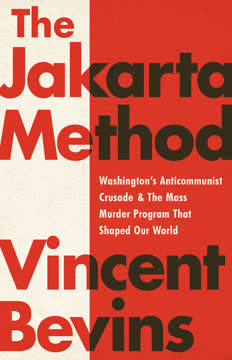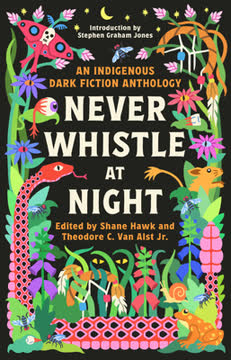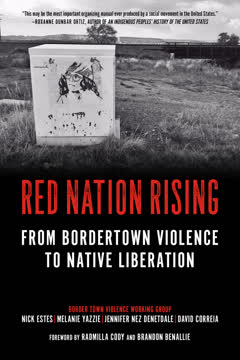Key Takeaways
1. The Bordertown: A Spatial Expression of Settler Colonial Violence
Every town is a bordertown, because every town serves as a border that settlers must defend.
Defining the Bordertown. The concept of the "bordertown" extends beyond a mere geographical location; it represents a fundamental relationship and ongoing project of settler colonialism. These are not just towns along international borders, but any settlement where settler order confronts Native order, making every settler town inherently a site of conflict and defense. This pervasive presence of the border highlights the constant, active failure of the settler project to fully eliminate Native presence.
Historical Roots. Bordertowns emerged from settler outposts, initially designed to contain "off the reservation" Indians and prevent enslaved Black people from seeking refuge in Native societies. These early settlements, often militarized, evolved into cities, embodying the settler's vision of "civilization" on the "western frontier." This historical trajectory reveals that the very existence of these towns is predicated on the violent dispossession and control of Native lands and peoples.
Everyday Violence. The bordertown imposes a million daily indignities on Native people, who are constantly made to feel "out of place" in their own lands. This environment fosters a "quotidian nature of white supremacy," where violence against Native individuals—from police brutality to vigilante attacks—becomes normalized and often goes unpunished. The constant crossing of these invisible borders, whether physical or jurisdictional, marks every Native step as a transgression of settler rule.
2. Anti-Indianism: The Ideology of Native Elimination
For settler societies, to ignore anti-Indianism is to participate in it.
Organizing Elimination. Anti-Indianism is the foundational ideology of North American settler societies, systematically organizing the elimination of Native peoples. It manifests in both subtle and overt ways, from racist depictions in popular culture and sports mascots to spectacular acts of genocidal violence. This ideology is deeply embedded in settler law and culture, shaping how society expresses itself and perpetuates Native dispossession.
Common Sense Consent. This anti-Indian common sense functions as a structured belief system, uncritically absorbed by settler citizens, compelling them to participate in the project of Native elimination. Unlike capitalism, which requires worker consent, settler colonialism primarily demands consent from the settler working class to uphold the system. This transforms the everyday obligation to dispossess Native land into a core aspect of settler identity and citizenship.
The "Indian Problem." The continued presence of Native people in "settled" territories poses a persistent challenge to the settler narrative of Native erasure, creating what has historically been termed the "Indian Problem." This problem is not about Native pathology but about the settler's inability to fully achieve Native elimination. Anti-Indianism, therefore, is a continuous performance of ownership and belonging at the expense of Native lives and sovereignty.
3. Police and Vigilantes: Enforcers of Settler Order and Indian Killers
Police are settler society’s Indian killers.
Fabricating Order. Police are violence specialists whose primary job is to fabricate and sustain a settler social order, often through violence or the threat of it. This order is built on the premise that Native peoples have no legitimate claim to their lands and are obstacles to settler claims. From their origins as scalp hunters, police have been agents of genocide, ensuring the "thin blue line" between "civilization" and "savagery" (Native presence).
Vigilantism as Law. Vigilantism, often romanticized as heroic self-defense in the "Wild West" myth, is an essential practice of settler colonialism, where private citizens take it upon themselves to uphold settler order, often with genocidal violence. This includes acts like "Indian rolling," a blood sport of brutal torture and murder targeting unsheltered Native people, which serves to terrorize and remind them they are "out of place." The Chokecherry Massacre in Farmington, New Mexico, where teenagers brutally murdered Navajo men, exemplifies this.
Beyond Brutality. The term "police brutality" is a reformist concept that obscures the inherent violence of policing in settler societies. It suggests that police violence is an aberration rather than a core function. To call for an end to police brutality is not to call for an end to police violence, but rather for more "justified" violence. True change requires recognizing police as an institution of genocide and calling for their abolition, thereby dismantling the settler social order they uphold.
4. Capitalism and Exploitation: The Economic Engine of Settler Colonialism
Capitalism needs colonialism and racism.
Blood-Soaked Origins. Capitalism, an economic system based on private ownership and wealth accumulation, arrived "dripping with blood," forcibly expropriating land and labor. In North America, it was built on stolen Native lands and the forced labor of enslaved Africans, making the United States the first nation born entirely as a capitalist state. This foundation required constant police and military violence to establish and maintain class and racial hierarchies.
Bordertown Economies. Bordertowns are economic hubs designed to exploit Native life, labor, and resources for settler wealth. These economies rely heavily on Native customers and cheap Native labor, yet Native people rarely own these businesses.
- Pawnshops, payday lenders, and liquor stores target vulnerable Native populations.
- The "Native art market" exploits Native cultural labor for the profit of wealthy gallery owners and traders.
- Extractive industries (oil, gas, coal, uranium) pollute Native lands while profits flow to corporations and white settlements, creating permanent economic inequalities.
Racial Capitalism. Capitalism uses racial differentiation to designate certain populations as exploitable and expendable. Native people are condemned to a permanent underclass, their lands and bodies treated as "natural resources" for profit. This system creates "wastelands" out of Native lives and homelands, ensuring that Native nations rarely benefit from the wealth extracted from their territories, making true sovereignty impossible.
5. Settler Constructs: Tools for Justifying Native Dispossession
The settler understands the hunt as a divine mission to kill.
Fabricating Difference. Settler societies employ various social constructs to justify Native dispossession and control. These constructs, often presented as natural or scientific, create a hierarchy of value that places Native people at the bottom, deeming them "prehuman" or "nonhuman."
- "Savage/Savagery": Defines Native people as outside civilization, justifying their elimination and the imposition of class order.
- "Drunk Indian": A racist stereotype used to excuse violence and exploitation, pathologizing Native alcohol use as a biological deficiency rather than a symptom of colonial oppression.
- "Homelessness": Categorizing unsheltered Native people as "homeless" or "transients" is a counterinsurgency tactic, framing them as enemies of the state and justifying their removal from their own homelands.
Controlling Narratives. Settler institutions, from academia to public education and media, perpetuate these constructs. "Indian experts" historically justified genocidal policies and continue to manage settler insecurity by depicting Native people as vanishing or pathological. "History" itself is whitewashed, promoting myths like New Mexico's "tri-cultural harmony" to minimize colonial violence and convert Native land claims into mere "cultural" contributions.
Charity and Liberalism. Even seemingly benevolent concepts like "charity" and "human rights" are settler scams. Churches and nonprofits profit from Native misery, using "charity" to proselytize and maintain colonial relationships. "Human rights," as defined by the liberal state, prioritize private property and limit belonging, effectively denying Native claims to land and collective freedom. Liberalism, with its emphasis on "life, liberty, and property," is inherently tied to the violence of Native dispossession.
6. Gender Violence: A Foundational Settler Colonial Practice
Gender violence, therefore, is a foundational settler colonial practice.
Imposing Binaries. Settler colonialism violently imposed Western, heteronormative gender binaries (masculine/feminine) onto Native societies that historically recognized and respected diverse gender identities. This imposition was not merely cultural but a strategic act to disrupt Native social organization and control. Spanish priests, for example, systematically tortured "joyas" or third-gender individuals, seeking to exterminate alternative political orders that challenged settler norms.
MMIWG2S Epidemic. The epidemic of Missing and Murdered Native Women, Girls, and Two-Spirit people (MMIWG2S) is a direct consequence of this foundational gender violence. Native women are disproportionately victims of sexual assault and murder, a crisis exacerbated in bordertowns and by extractive industries.
- "Man camps" associated with oil and gas exploitation lead to increased rates of sexual harassment, assault, and trafficking.
- Tribal authorities often lack jurisdiction or resources to address these crimes effectively.
- The settler state's recognition of MMIWG2S is often performative, failing to dismantle the underlying structures that enable this violence.
Land and Bodies. Native feminists highlight the integral link between the rape of Native women and the conquest of Native land, viewing women's bodies as extensions of Mother Earth. Forced sterilization of Native women, a eugenicist practice, further illustrates the settler state's attempt to control Native reproduction and population, directly linking gender violence to the goal of Native elimination and land acquisition. Liberation requires dismantling heteropatriarchy alongside settler colonialism.
7. The Illusion of Reform: Why Settler Systems Cannot Be Redeemed
The bordertown cannot be reformed and settler society cannot be redeemed.
Systemic, Not Aberrant. Settler colonialism is not a series of unfortunate historical events or individual acts of bigotry; it is a violent, ongoing structure. Attempts to "reform" this system, such as civil rights reports or calls for "cultural sensitivity," are ultimately insufficient because they fail to address the fundamental reliance of the settler state on Native elimination. These reforms often serve to pacify resistance and maintain the illusion of progress without altering the core power dynamics.
Trauma and Reconciliation. The neoliberal paradigm of "trauma" and "healing," while acknowledging harm, can inadvertently depoliticize Native struggles. Concepts like "historical trauma" risk individualizing colonialism, focusing on victims rather than dismantling the system itself. "Reconciliation" efforts, like those in Canada, often offer inclusion and social programs instead of land return and the abolition of settler colonialism, effectively deferring true justice.
No "Good" Settler State. The settler state, by its very nature, cannot be a source of Native liberation. Its institutions—law, police, education, public health—are designed to perpetuate Native dispossession and control. "Human rights" are state-defined and limited, serving to legitimize state power rather than guarantee intrinsic human dignity. Any solution offered by the settler state, from "anti-poverty" programs to "civil rights," is a "Trojan Horse" that smuggles in colonial ideology while changing nothing fundamental.
8. Kinship and Solidarity: The Foundation of Native Resistance
Ours is a kinship built for the future, because it is a kinship that survived the past.
Beyond Settler Definitions. Native kinship is a profound, enduring connection to land, all beings (human and other-than-human), and across generations, defying settler definitions of family or property. It is a political force that resists the alienation and loss imposed by colonialism, offering a vision of collective well-being, reciprocity, equality, and justice. This kinship is not merely a cultural artifact but a living practice that forms the basis of Native liberation.
Kinship in Action. Kinship manifests in everyday acts of resistance and mutual aid:
- Support networks for Native transwomen in predatory economies.
- Intergenerational groups of unsheltered Native people protecting each other from violence.
- Grassroots organizations providing solidarity meals and supplies to relatives in bordertowns.
- Environmental justice struggles, like Standing Rock, renewing ties with land and water.
Lateral Solidarity. True solidarity for Native liberation is primarily lateral, connecting oppressed and colonized groups globally (e.g., Native, Black, Palestinian, migrant, LGBTQI2S struggles). This contrasts with "vertical solidarity," which often involves privileged groups offering limited support without challenging their own social location or the underlying class contradictions. Lateral solidarity builds collective power to overthrow class hierarchy and achieve revolutionary change.
9. Decolonization and Abolition: The Path to Native Liberation
Decolonization and abolition are not mutually exclusive.
Dismantling Systems. Native liberation requires a radical transformation, not mere reform, through decolonization and abolition. Decolonization means overthrowing the fundamental coloniality that defines the relationship between settler states and Native nations, leading to the demise of settler states and the restoration of Native sovereignty. Abolition extends this to dismantling carceral systems—prisons and police—which are instruments of class and colonial rule.
Beyond "Healing" and "Reconciliation." While trauma is real, a politics focused solely on "healing" and "reconciliation" with oppressors risks pacifying revolutionary demands. These liberal approaches often avoid confronting the material conditions of colonialism and capitalism, which are the root causes of trauma. Decolonization demands justice, which means holding pernicious agents of settler colonialism responsible and dismantling the structures that perpetuate Native destruction.
Abolishing Property. A core tenet of this path is the abolition of private property, which is seen as the foundation of settler kinship and the mechanism for land theft.
- Private property mediates all settler relations, defining their "freedom" as the right to dominate and accumulate.
- Its origins are in the blood of Native and Black ancestors.
- Abolishing private property liberates land from borders and enables the redistribution of wealth.
This revolutionary program seeks to replace the settler world with a Native world based on reciprocity, equality, and justice, where classes cease to exist and land is restored to its rightful relations.
10. The Bordertown Manifesto: A Call to Action for a Native Future
The bordertown must die for Native people to live.
A Native Future. The manifesto declares that the future is Native, envisioning a world no longer governed by the logic of the bordertown. Native kinship, resilient and expansive, will be the foundation for this liberation, forming alliances with all who resist settler order. This future will emerge from the "ashes of the bordertown," where stolen land and wealth will be redistributed, creating abundance and equality for all life.
Confronting Settler Precarity. Settlers are depicted as exiles, haunted by the precarity of their presence on stolen land. Their "viciousness and savagery" are compensatory for this insecurity, driving their fear and loathing of Native people. The Second Amendment, for instance, is understood as a manifestation of this settler fear, constituting violence as a core logic of their social relations. Their occupation is temporary, and their days are numbered.
Burning the Village. The manifesto calls for the destruction of the bordertown, not as an act of revenge, but of creation and reclamation. This means abolishing private property, which mediates all settler kinship and freedom, and dismantling the heteropatriarchal "man camps" that define settler identity and violence. The goal is a world without borders, where capitalism and settler colonialism cease to exist, and Native people are free to live in peace and harmony with all relations.
Last updated:
Review Summary
Red Nation Rising receives high praise from readers for its unflinching examination of settler colonialism and Native American struggles. Reviewers appreciate its analysis of bordertowns, anti-Indian violence, and the ongoing impacts of colonization. The book is described as a powerful manifesto for decolonization and resistance, offering a framework for Native liberation. While some note its lack of practical solutions, most commend its thought-provoking content and call to action. Readers find it enlightening, challenging, and necessary for understanding Indigenous perspectives and the ongoing effects of historical injustices.
Similar Books






Download PDF
Download EPUB
.epub digital book format is ideal for reading ebooks on phones, tablets, and e-readers.





